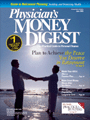Publication
Article
Physician's Money Digest
Slice and Dice Today's Solo 401(k) Plan
Author(s):
Thanks to the Economic Growth and Tax ReliefReconciliation Act of 2001, it became easierfor the self-employed to establish a solo 401(k)plan. These plans offer great tax-deferral optionsand savings opportunities for the self-employed.So, if you own your own practice and don't have a plan,you may want to consider if one is right for you.
Sole proprietors, partnerships, corporations (includingS-corporations), limited liability companies, andlimited liability partnerships may all establish their ownsolo 401(k) plan. In 2005, the maximum contributionlimit for participants is $42,000, or $46,000 if you'reage 50 or older. When it comesto saving for retirement, a solo401(k) offers self-employedphysicians many advantages.Following is a list ofsome of them:
•Higher contributionlimits. You can contributemore to a solo 401(k)plan on less income than you canto an IRA, SIMPLE IRA, or simplifiedemployee pension (SEP)-IRA.
•Flexible contributions. If your practice had agood year, you can contribute more to the plan (withincontribution limits). And you can always put inless, or nothing at all.
•Multiple plans. Doctors with a side business areprime candidates for a solo 401(k). You can haveyour plan at work and still open another one foryour side business.
•Easy transitions. You can roll over other retirementaccounts into your 401(k).
•Loan opportunities. You can borrow 50% ofyour account balance (up to $50,000) and repay itover 5 years; if the loan is used to acquire a principalresidence, you'll have 15 years to repay it. The interestis paid back into your own 401(k) account and isnondeductible regardless of the loan's purpose. Youcannot borrow from an IRA or SEP-IRA, but youcan roll them over into your 401(k) plan and thenborrow money from it.
•Brokerageaccount options.Your solo 401(k) planmay include a self-directedbrokerage account; these accounts offer plan participantsgenerous investment flexibility.
•No tax returns. You don't have to file a taxreturn for the plan if your assets don't exceed$100,000. If your assets do exceed $100,000, a simplifiedtax return may be filed.
Taxation
note:
•No FICA taxes. The employer contribution portion isnot subject to FICA or self-employment taxes. Any salary deferral portion is subject to taxes.
•Extended contribution dates. Employer contributions may be made after the end of the year, as longas they're made by the tax return deadline or theextension deadline.
Now that you have an idea of how a solo 401(k) plancan help you save for the golden years, here are somethings you should look for when shopping for a plan:
•No-load funds. To minimize long-term expenses,ask whether there are broker commissions or loads(ie, up-front or back-end commissions) that you mustpay. Many solo 401(k) plans require you to pay up to5.75% of your initial investment in a load fee.
•Open architecture. Look for a solo 401(k) planwith a self-directed brokerage account that allows youto invest in stocks, bonds, options, real estate, andmutual funds.
•Index funds. If you're not aware, these funds aredesigned to track the major stock and bond indexesand usually have lower expense ratios than activelymanaged funds.
•No/low annual and set-up fees. Several companiesoffer solo 401(k) plans, and some brokers will provideyou with a free report on the annual and set-up feescharged by different solo 401(k) plans. Request a comparisonof the fees for at least two plans.
•Low administrative fees. Before you make a decision,compare the administrative and load fees of afew plans to make sure you won't be paying too muchfor your plan.
•Online access. Consider a plan that allows youto modify your account online.
•Low expense ratios. If you plan on investing inmutual funds, find out what the expense ratio is. Theexpense ratio is the percentage of assets gobbled up bythe fund manager to manage the fund. Included in theexpenses may be an unnecessary fee called a 12b1 fee,which usually goes to a broker. Expense ratios varyand directly impact your return.
At www.morningstar.com, you can look up theexpense ratio for any fund as well as find funds thatdon't include a 12b1 fee. After all, when it comes tosaving for retirement, every penny counts. For example,let's say you save $500,000 and your 401(k)charges 0.75% a year. Over 30 years—assuming an8% return and no additional contributions—an extra0.25 percentage points in fees or expenses will cutyour nest egg by more than $292,000, according tothe SEC's cost calculator at www.sec.gov.
Craig Lewis Gillooly, JD, is an attorney whospecializes in administering solo 401(k) plansand is the CEO of 401kbrokers.com. Mr.Gillooly welcomes questions or comments atcraig@401kbrokers.com.
